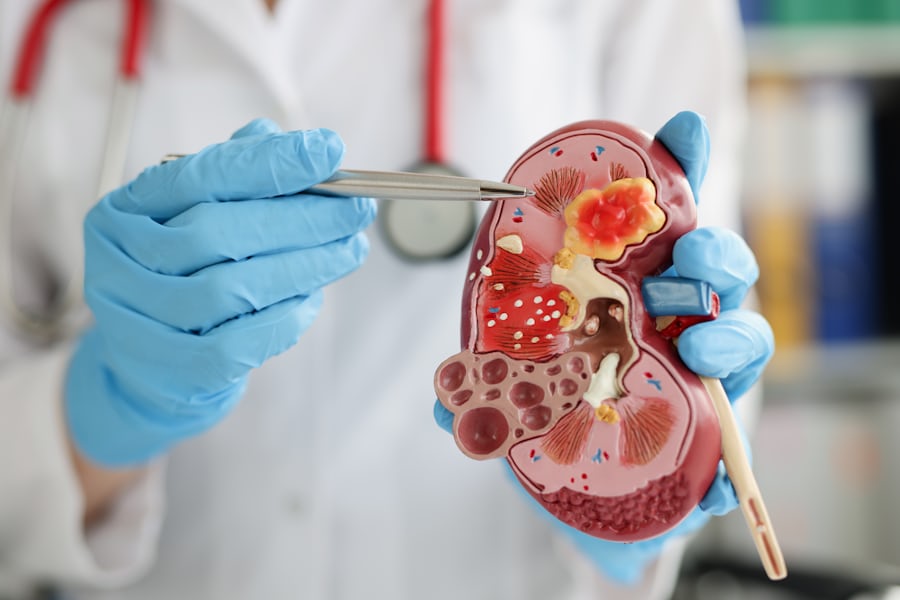Kidney Stones: A Comprehensive Overview
Kidney stones, also known as renal calculi, are hard deposits of minerals and salts that form inside the kidneys. These stones can vary in size from as small as a grain of sand to as large as a golf ball. While some stones may pass out of the body unnoticed, larger stones can cause excruciating pain and may require medical intervention.
Symptoms: The Telltale Signs
The most common symptom of a kidney stone is a sharp, cramping pain in the back and side, often radiating to the lower abdomen and groin. This pain, known as renal colic, can come in waves and may be accompanied by:
Blood in the urine (hematuria), which may appear pink, red, or brown.
Cloudy or foul-smelling urine.
A persistent urge to urinate.
Urinating more often than usual or in small amounts.
Nausea and vomiting.
Fever and chills, which may indicate an infection.
The intensity of the pain is not always related to the size of the stone. A small, sharp-edged stone can be as painful as a larger, smoother one.
Causes and Risk Factors: Why Do Stones Form?
Kidney stones form when your urine contains more crystal-forming substances — such as calcium, oxalate, and uric acid — than the fluid in your urine can dilute. At the same time, your urine may lack substances that prevent crystals from sticking together, creating an ideal environment for stone formation.
Several factors can increase your risk of developing kidney stones:
Dehydration: Not drinking enough water is a primary risk factor.
Diet: Diets high in protein, sodium, and sugar can increase the risk of certain types of stones. High-oxalate foods like spinach, rhubarb, nuts, and wheat bran can also contribute.
Obesity: A high body mass index (BMI) is associated with an increased risk.
Family or Personal History: If you or a family member has had kidney stones, you are more likely to develop them.
Medical Conditions: Certain medical conditions, such as urinary tract infections, Crohn’s disease, and renal tubular acidosis, can increase your risk.
Supplements and Medications: Taking certain supplements, like vitamin C in high doses, and some medications can contribute to stone formation.
Types of Kidney Stones: A Look at Their Composition
Understanding the type of kidney stone is crucial for determining the appropriate prevention and treatment strategies. The main types include:
Calcium Oxalate Stones: The most common type, often linked to dietary factors.
Calcium Phosphate Stones: These stones are often associated with underlying metabolic conditions.
Struvite Stones: These form in response to a urinary tract infection. They can grow quickly and become quite large, sometimes with few symptoms initially.
Uric Acid Stones: More common in men, these stones can form in people who don’t drink enough fluids or who have a high-protein diet. They are also associated with gout.
Cystine Stones: These are rare and form in people with a hereditary disorder called cystinuria that causes the kidneys to excrete too much of a specific amino acid.
Diagnosis and Treatment: From Observation to Intervention
If your doctor suspects you have a kidney stone, they will likely recommend one or more of the following tests:
Urine tests to check for crystals, bacteria, and blood.
Blood tests to check for high levels of certain minerals.
Imaging tests, such as CT scans or X-rays, to see the size, shape, and location of the stones.
Treatment for kidney stones varies depending on the type, size, and location of the stone, as well as the severity of symptoms.
Small stones with minimal symptoms: For these, your doctor may recommend drinking plenty of water (2 to 3 quarts a day) to help flush the stone out. Pain relievers may also be prescribed.
Large stones and those that cause symptoms: For larger stones that are unlikely to pass on their own or are causing significant pain or obstruction, more invasive treatments may be necessary. These can include:
Extracorporeal shock wave lithotripsy (ESWL): This procedure uses sound waves to create strong vibrations (shock waves) that break the large stones into smaller pieces that can then be passed in your urine.
Ureteroscopy: A thin, lighted tube (ureteroscope) equipped with a camera is passed through the urethra and bladder to the ureter. Once the stone is located, special tools can be used to snare the stone or break it into smaller pieces.
Percutaneous nephrolithotomy: This surgical procedure involves removing a kidney stone using small telescopes and instruments inserted through a small incision in your back. This is typically reserved for very large stones.
Prevention: Keeping Future Stones at Bay
Preventing future kidney stones is a key part of management. General recommendations include:
Staying hydrated: Drinking plenty of fluids, primarily water, is the most important preventive measure.
Dietary modifications: Depending on the type of stone you had, your doctor may recommend specific dietary changes. This could include reducing sodium and animal protein intake or avoiding high-oxalate foods.
Medications: For some individuals, medications may be prescribed to help prevent the formation of certain types of stones.
It is essential to work with your healthcare provider to determine the best course of prevention and treatment for your specific situation.


